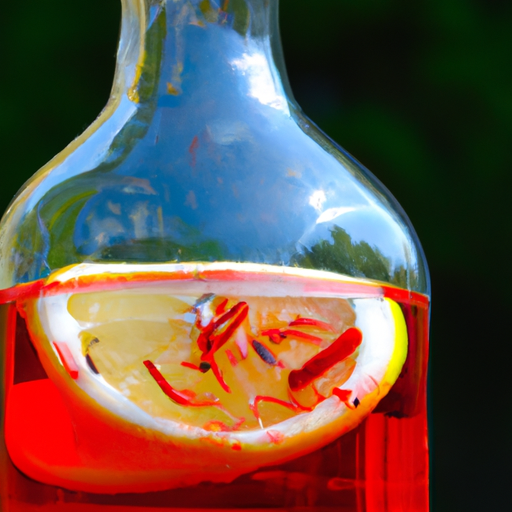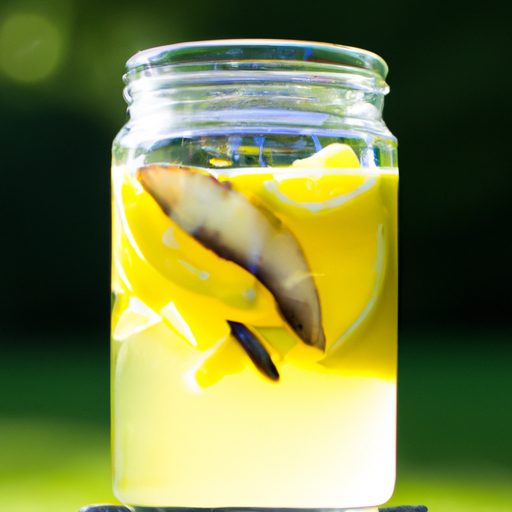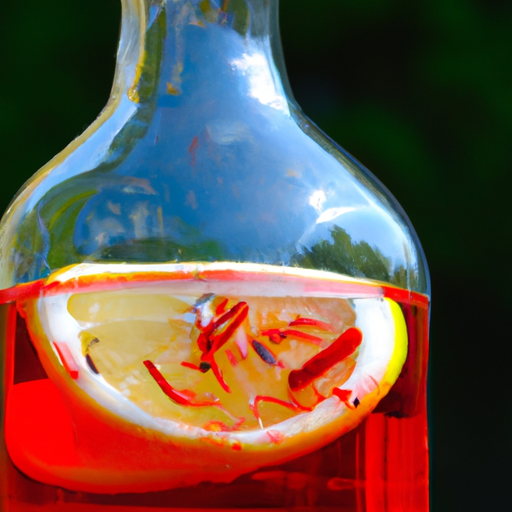Are you tired of pesky flies buzzing around your home? Look no further, as we have the solution for you! In this article, we will explore five incredibly simple yet effective homemade fly traps that can easily be made with items you likely already have in your kitchen. These traps are not only cost-effective, but they are also environmentally friendly alternatives to store-bought traps. Say goodbye to annoying flies and hello to a fly-free home with these ingenious homemade solutions!

1. Jar Trap
Materials needed
- A wide-mouth jar or container
- Some sweet bait (e.g., fruit, honey, or syrup)
- Plastic wrap
- Rubber band
- Toothpick or pin
- Scissors
Instructions
- Take the wide-mouth jar or container and clean it thoroughly.
- Pour a small amount of sweet bait into the jar, such as fruit juice, honey, or syrup.
- Cover the jar with plastic wrap and secure it with a rubber band around the rim.
- Use a toothpick or pin to poke a few holes in the plastic wrap.
- Place the trap in areas where flies are commonly found, such as near windows or trash bins.
How it works
The jar trap works by attracting flies to the sweet bait inside the jar. Flies are drawn to the enticing smell and will enter through the holes in the plastic wrap. Once inside, they will have difficulty finding their way out through the small holes, ultimately becoming trapped inside the jar.
Maintenance tips
- Check the trap regularly to ensure that it has not become too full of flies. If needed, empty the trap and replace the sweet bait.
- Clean the jar trap regularly to prevent the buildup of dead flies and bacteria.
Benefits
- Simple to make and requires minimal materials.
- Chemical-free and safe to use around children and pets.
- Effectively captures flies and helps to reduce their population indoors.
2. Vinegar Trap
Materials needed
- Apple cider vinegar
- Liquid dish soap
- Plastic wrap
- Rubber band
- Toothpick or pin
- Scissors
Instructions
- Take a small bowl or cup and pour apple cider vinegar into it.
- Add a few drops of liquid dish soap to the vinegar.
- Cover the bowl with plastic wrap and secure it with a rubber band around the rim.
- Use a toothpick or pin to poke a few holes in the plastic wrap.
- Place the trap in areas where flies are commonly found.
How it works
The vinegar trap capitalizes on the attractive scent of apple cider vinegar to lure flies. The addition of dish soap breaks the surface tension of the vinegar, causing flies to sink into the liquid and drown.
Maintenance tips
- Monitor the trap regularly and replace the vinegar mixture as needed.
- Clean the trap regularly to prevent the buildup of dead flies and bacteria.
Benefits
- Vinegar traps are easy to set up and require only a few household items.
- Apple cider vinegar is an effective fly attractant.
- The addition of dish soap increases the trap’s effectiveness by trapping flies in the liquid.
3. Paper Cone Trap
Materials needed
- A piece of paper
- Tape or stapler
- Sweet bait (e.g., fruit, honey, or syrup)
Instructions
- Take a piece of paper and roll it into a cone shape, with a pointed tip and a wide open end.
- Secure the cone shape with tape or staples to keep it in place.
- Place the cone upside down into a jar or container with the narrow end pointing downwards.
- Pour some sweet bait, such as fruit juice, honey, or syrup, into the bottom of the jar, making sure it does not touch the sides.
- Place the trap in areas where flies are commonly found.
How it works
The paper cone trap entices flies with the sweet bait placed at the bottom of the jar. Flies will be drawn to the scent and will try to reach the bait by entering through the wide open end of the cone. However, once inside, they will have difficulty finding their way out through the narrow opening, effectively trapping them inside the jar.
Maintenance tips
- Check the trap regularly and empty it as needed.
- Clean the trap regularly to prevent the buildup of dead flies and bacteria.
Benefits
- The paper cone trap is easy to assemble using common household materials.
- It provides an effective way to capture flies without the use of chemicals.
- The trap can be easily disposed of and replaced when necessary.
4. Milk, Sugar, and Pepper Trap
Materials needed
- Milk
- Sugar
- Crushed black pepper
- Small bowl or plate
Instructions
- Take a small bowl or plate and pour an equal amount of milk and sugar into it.
- Sprinkle a generous amount of crushed black pepper on top of the milk and sugar mixture.
- Place the bowl or plate in areas where flies are commonly found.
How it works
The milk, sugar, and pepper trap utilizes the combination of sweet and pungent smells to attract flies. Flies will be enticed by the scent of the mixture and will be drawn to it. However, the black pepper acts as an irritant to the flies, causing them to stay away from the trap.
Maintenance tips
- Replace the milk, sugar, and pepper mixture regularly to maintain its effectiveness.
- Clean the bowl or plate regularly to prevent the buildup of flies and bacteria.
Benefits
- The ingredients for this trap are readily available in most households.
- It offers a natural and safe method to repel flies.
- The trap is easy to set up and does not require any complicated equipment.

5. Plastic Bottle Trap
Materials needed
- Plastic bottle with a screw-on cap (e.g., soda or water bottle)
- Knife or scissors
- Sweet bait (e.g., fruit, honey, or syrup)
- Soapy water or insecticidal soap
Instructions
- Take the plastic bottle and remove the label if necessary.
- Cut off the top third of the bottle using a knife or scissors.
- Invert the top third of the bottle and place it inside the remaining bottom part, creating a funnel-like shape.
- Secure the two parts together with tape or glue if desired.
- Pour sweet bait, such as fruit juice, honey, or syrup, into the bottom part of the bottle.
- Fill the surrounding area with soapy water or insecticidal soap to drown the flies.
How it works
The plastic bottle trap works by attracting flies to the sweet bait inside the bottle. Flies are lured into the bottle through the funnel-like structure but are unable to find their way out. The soapy water or insecticidal soap surrounding the bait drowns the trapped flies.
Maintenance tips
- Check the trap regularly to ensure that it has not become too full of flies. If needed, empty the trap and replace the sweet bait.
- Clean the trap regularly to prevent the buildup of dead flies and bacteria.
Benefits
- Plastic bottle traps can be easily made using recyclable materials.
- The funnel-like design increases the efficiency of capturing flies.
- This trap is cost-effective and environmentally friendly.
6. Apple Cider Vinegar Trap
Materials needed
- Apple cider vinegar
- Dish soap
- Plastic wrap
- Rubber band
- Toothpick or pin
- Scissors
Instructions
- Take a small bowl or cup and pour apple cider vinegar into it.
- Add a few drops of dish soap to the vinegar and mix gently.
- Cover the bowl with plastic wrap and secure it with the rubber band around the rim.
- Use a toothpick or pin to poke a few holes in the plastic wrap.
- Place the trap in areas where flies are commonly found.
How it works
The apple cider vinegar trap uses the strong scent of vinegar to lure flies. When flies are attracted to the vinegar and attempt to land on it, the dish soap reduces the surface tension of the liquid, causing the flies to sink and drown.
Maintenance tips
- Monitor the trap regularly and replace the vinegar mixture as needed.
- Clean the trap regularly to prevent the buildup of dead flies and bacteria.
Benefits
- Apple cider vinegar is an effective fly attractant.
- The addition of dish soap increases the trap’s effectiveness by drowning flies.
- This trap is simple to assemble and requires minimal materials.
7. Wine Trap
Materials needed
- Red or white wine
- Dish soap
- Plastic wrap
- Rubber band
- Toothpick or pin
- Scissors
Instructions
- Take a small bowl or cup and pour red or white wine into it.
- Add a few drops of dish soap to the wine and mix gently.
- Cover the bowl with plastic wrap and secure it with the rubber band around the rim.
- Use a toothpick or pin to poke a few holes in the plastic wrap.
- Place the trap in areas where flies are commonly found.
How it works
The wine trap utilizes the sweet and fruity scent of wine to attract flies. When flies land on the wine, the addition of dish soap reduces the surface tension of the liquid, causing the flies to sink and drown.
Maintenance tips
- Monitor the trap regularly and replace the wine mixture as needed.
- Clean the trap regularly to prevent the buildup of dead flies and bacteria.
Benefits
- Wine traps are simple to set up and require only a few household items.
- The scent of wine is an effective fly attractant.
- The addition of dish soap increases the trap’s effectiveness by drowning flies.
8. Citrus Trap
Materials needed
- Citrus fruit (e.g., orange, lemon, or lime)
- Knife or scissors
Instructions
- Take a citrus fruit and cut into halves.
- Scoop out the flesh from both halves, leaving the rind intact.
- Invert one of the halves and place it on top of the other, creating a dome-like shape.
- Place the trap in areas where flies are commonly found.
How it works
The citrus trap takes advantage of the strong scent of citrus fruits to attract flies. Flies will be enticed by the smell and will be drawn to the trap. Once inside the dome-like structure, they will have difficulty finding their way out, effectively trapping them inside.
Maintenance tips
- Check the trap regularly and empty it as needed.
- Replace the citrus fruit as it starts to dry out or loses its scent.
Benefits
- Citrus traps are easy to assemble using readily available fruits.
- They offer a chemical-free and eco-friendly way to control flies.
- The traps can be disposed of easily and replaced when necessary.
9. Honey Trap
Materials needed
- Honey
- Small container or dish
Instructions
- Take a small container or dish and pour a generous amount of honey into it.
- Place the trap in areas where flies are commonly found.
How it works
The honey trap uses the sticky and sweet nature of honey to attract flies. Flies will be drawn to the scent and will be lured towards the trap. Once they land on the honey, they will become stuck, effectively trapping them.
Maintenance tips
- Monitor the trap regularly and replace the honey as it starts to dry out or becomes too filled with flies.
- Clean the container or dish regularly to prevent the buildup of dead flies and bacteria.
Benefits
- Honey traps are simple to set up and require only a small amount of honey.
- They offer a natural and safe method to capture flies without the use of chemicals.
- The trap can be easily disposed of and replaced when needed.
10. Red Wine Trap
Materials needed
- Red wine
- Small bowl or dish
Instructions
- Take a small bowl or dish and pour a sufficient amount of red wine into it.
- Place the trap in areas where flies are commonly found.
How it works
The red wine trap capitalizes on the fruity and sweet scent of red wine to attract flies. Flies will be enticed by the aroma and will be drawn towards the trap. Once they land on the wine, they will become trapped by the liquid.
Maintenance tips
- Monitor the trap regularly and refill it with red wine as needed.
- Clean the container or dish regularly to prevent the buildup of dead flies and bacteria.
Benefits
- Red wine traps are easy to set up and require only a small amount of wine.
- They provide a natural and effective way to control flies indoors.
- The trap can be easily replaced when necessary.
In conclusion, there are various homemade fly traps that you can create using simple materials found around your home. These traps offer an effective and chemical-free solution to control flies and reduce their population. Whether using jar traps, vinegar traps, paper cone traps, or other methods, maintaining and cleaning the traps regularly is essential for their continued effectiveness. By employing these homemade fly traps, you can enjoy a fly-free environment while avoiding the use of harmful chemicals.




